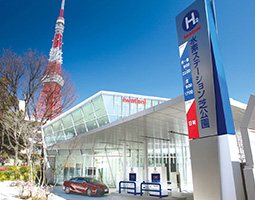Home > Highlighting JAPAN > Highlighting Japan September 2016 > Japan’s Fight Against Global Warming
Highlighting JAPAN


FCVs: The Cars of the Very Near Future
Efforts to popularize fuel cell vehicles are underway in Japan, the first country to introduce such vehicles to the market.
In December 2014, Toyota Motor Corporation launched its FCV, the Mirai, becoming the first company in the world to commercialize a fuel cell vehicle. In March 2016, Honda Motor Co. launched the Clarity Fuel Cell. Nissan is also working to commercialize its own FCVs by collaboratively developing fuel cells with Daimler.
An FCV is equipped with a fuel cell (FC) stack, a high-pressure hydrogen tank and a drive motor. Sending oxygen from the air and hydrogen from the hydrogen tank to the FC stack initiates a chemical reaction and generates electricity. This electricity is used to drive the motor and run the vehicle. Unlike conventional IC engine-powered vehicles, FCVs do not emit any carbon dioxide, nitrogen oxide, particulate substance or anything else that may adversely affect the environment. This is why an FCV is referred to as the ultimate eco-car.
FCVs are similar to electric vehicles (EVs) in that they run by using electric power to drive the motor. One difference is that an EV involves externally recharging the in-vehicle storage battery, whereas an FCV generates electric power using the in-vehicle stored hydrogen by fuel cell. An EV requires nearly eight hours to recharge in a household (nearly 30 minutes for a rapid recharge) whereas an FCV is capable of being filled with hydrogen, its fuel, in about three minutes at a hydrogen refueling station (HRS). The driving range of EVs varies significantly among vehicle types. The Nissan Leaf, the world’s best-selling EV model, has a range of nearly 230 kilometers, whereas the range of FCVs is far greater at nearly 650 kilometers for the Mirai and 750 kilometers for the Clarity Fuel Cell.
“In the future, users will use EVs and FCVs differently,” says Tomohide Satomi, deputy director general of the Fuel Cell Commercialization Conference of Japan (FCCJ), “choosing the former for traveling short distances in urban areas and the latter for long-distance driving.”
To facilitate the industry-academia-government efforts to achieve a hydrogen-oriented society, the Ministry of Economy, Trade and Industry formulated the Strategic Road Map for Hydrogen and Fuel Cells in June 2014. The revised road map was published in March 2016, setting the cumulative target for the popularization of FCVs at 40,000 vehicles by 2020, 200,000 vehicles by 2025 and 800,000 vehicles by 2030.
The popularization of FCVs will require lower prices. Both the Mirai and the Clarity Fuel Cell are expensive at the 7 million yen (70,000 USD) level. They would still be priced at the 4 million yen level even if they were subsidized by the national or local government. According to the new road map, second-generation FCVs will be launched around 2020, while third-generation types are expected to be introduced to the market by 2025. Automakers aim to reduce the cost of fuel cell systems for FCVs to nearly one-fourth of the current level by 2025 so that the prices of FCVs will be equivalent to those of hybrid cars. Toyota’s Prius, the representative hybrid car of today, is priced at the 3 million yen level.
Continuing the popularization efforts also requires more hydrogen refueling stations to be built. Currently, the national government eases many different regulations and subsidizes half of the cost of the construction of hydrogen refueling stations, which amounts to 400 million to 500 million yen per location. As of September 2016, nearly 80 public hydrogen refueling stations are in service in Japan. This figure is expected to reach 100 by the end of this fiscal year. The new road map clearly states that the number of hydrogen refueling stations in Japan will increase to 160 by fiscal 2020 and 320 by fiscal 2025. The road map also stipulates that the hydrogen station business will become unsubsidized by the latter half of the 2020s, and that hydrogen stations will be reliably available to FCV users nationwide by around 2040.
“Now that the new road map has specified numerical targets, moves toward the popularization of FCVs will undoubtedly be accelerated,” says Satomi. “Japan will be the first country in the world to develop a low-carbon society and make a contribution to the whole world through eco-friendly technologies.”
© 2009 Cabinet Office, Government of Japan







